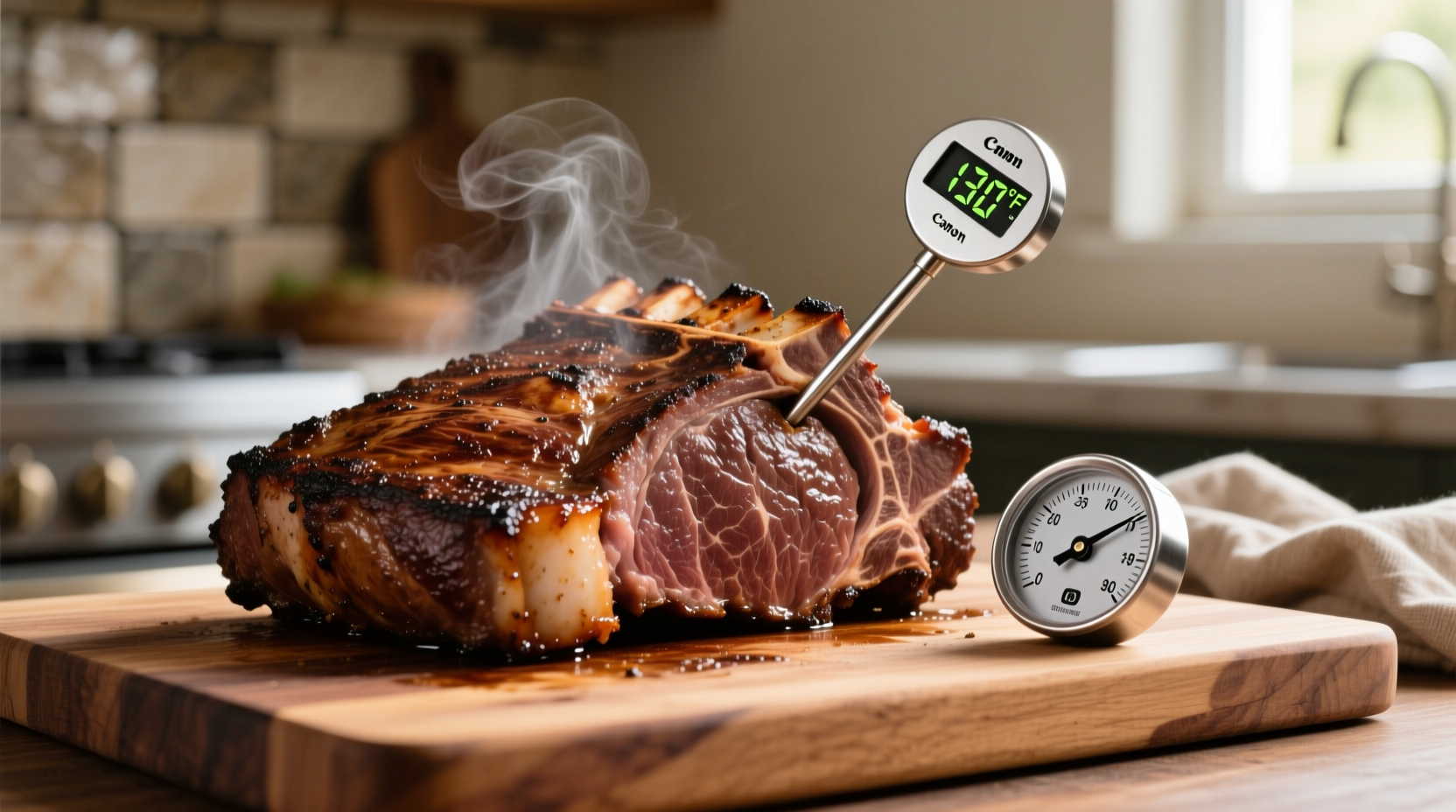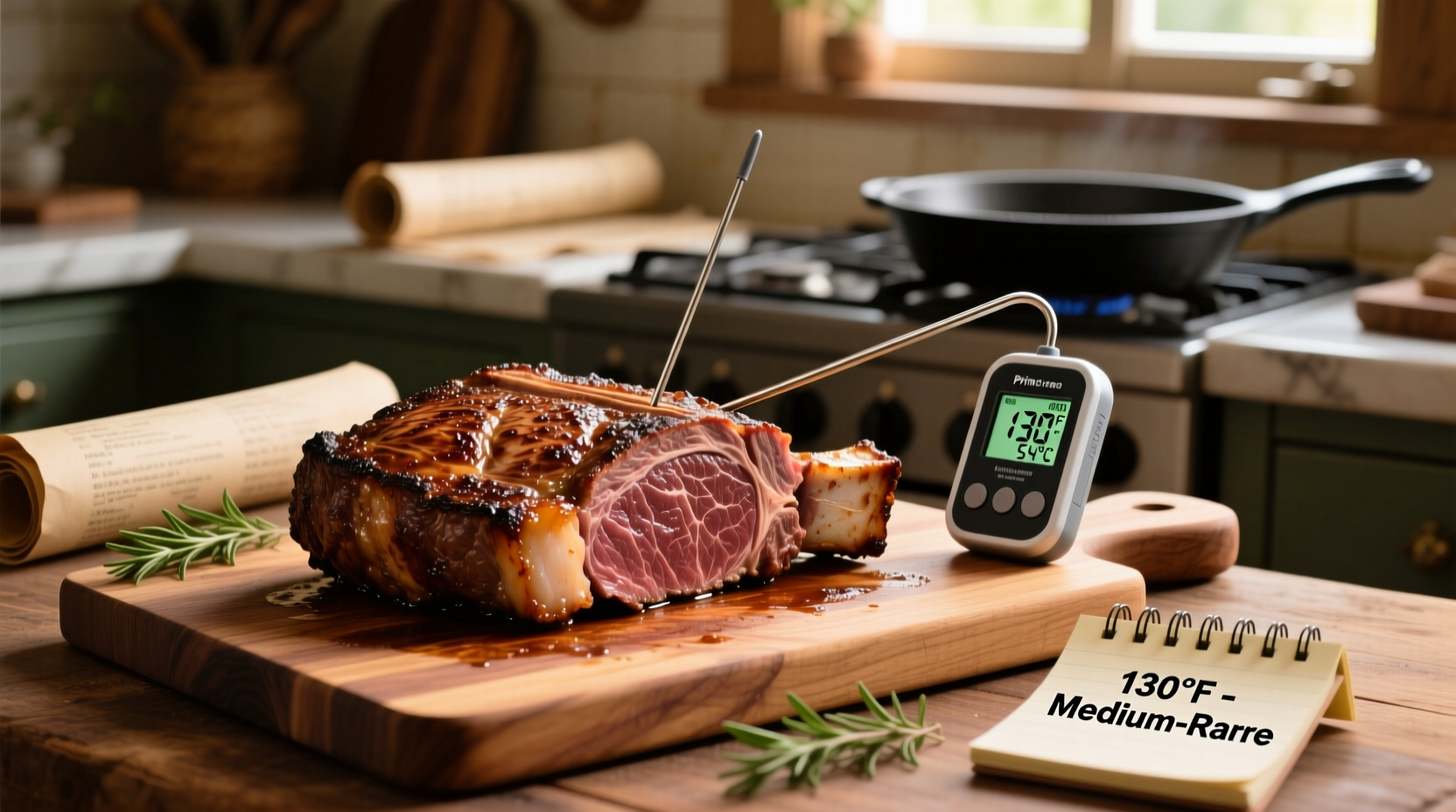The ideal internal temperature for cooking prime rib is 130-135°F (54-57°C) for perfect medium-rare doneness after resting. Insert your meat thermometer into the thickest part of the roast, avoiding bone, and remove the roast from oven when it reaches 120-125°F (49-52°C) to account for 5-10 degree temperature rise during resting.
Nothing compares to a perfectly cooked prime rib—tender, juicy, with that beautiful pink center we all crave. But hitting the right temperature can make or break your holiday centerpiece. Get it wrong, and you'll end up with dry, overcooked meat that costs a small fortune to replace. Let's cut through the confusion and give you the precise temperature roadmap every home cook needs.
The Science Behind Prime Rib Temperature
Cooking prime rib isn't just about hitting a number—it's understanding the science of meat transformation. As beef heats up, proteins denature and moisture redistributes. The USDA recommends a minimum safe temperature of 145°F for beef, but culinary professionals know prime rib reaches its peak texture and juiciness well before that point.
Here's what happens at different temperature ranges:
| Doneness Level | Internal Temperature (°F) | Internal Temperature (°C) | Visual Characteristics |
|---|---|---|---|
| Rare | 120-125°F | 49-52°C | Bright red center, very soft texture |
| Medium-rare (Recommended) | 130-135°F | 54-57°C | Warm red center, tender with slight resistance |
| Medium | 140-145°F | 60-63°C | Pink center, firmer texture |
| Medium-well | 150-155°F | 66-68°C | Slightly pink center, quite firm |
| Well-done | 160°F+ | 71°C+ | Little to no pink, very firm, often dry |
According to research from the Culinary Institute of America, medium-rare (130-135°F) delivers optimal tenderness and moisture retention for prime rib. The USDA Food Safety and Inspection Service confirms that beef cooked to 130°F and held for at least 112 minutes is safe to eat, though most home cooks don't maintain that temperature long enough—making 135°F the practical safety threshold for immediate serving.
Step-by-Step Temperature Guide for Perfect Prime Rib
1. Preparation: Setting Up for Temperature Success
Before you even turn on your oven, proper preparation ensures accurate temperature readings:
- Bring your prime rib to room temperature (about 2 hours out of fridge)
- Use an instant-read digital thermometer or leave-in probe thermometer
- Position thermometer in the geometric center of the roast's thickest section
- Ensure thermometer doesn't touch bone or the pan
2. Cooking Process: Hitting the Target Temperature
Follow this temperature roadmap for consistent results:
- Preheat oven to 450°F (232°C) for 30 minutes
- Sear the roast at high heat for 15-20 minutes to develop crust
- Reduce heat to 325°F (163°C) for gentle, even cooking
- Monitor temperature closely during final 30 minutes of cooking
- Remove from oven when thermometer reads 120-125°F (49-52°C) for medium-rare
- Rest for 20-30 minutes—this allows temperature to rise 5-10 degrees to perfect 130-135°F

3. Avoiding Common Temperature Mistakes
Even experienced cooks make these temperature errors:
- Mistake: Checking temperature too frequently
Solution: Open oven no more than 2-3 times during cooking to prevent heat loss - Mistake: Not accounting for carryover cooking
Solution: Always remove roast 5-10 degrees below target final temperature - Mistake: Placing thermometer near bone
Solution: Insert probe into center of meat, away from bone which conducts heat differently - Mistake: Cutting into roast to check doneness
Solution: Rely solely on thermometer—never use the "fork test" which releases precious juices
Special Considerations for Different Cooking Methods
While conventional oven cooking is most common, temperature targets vary slightly with different methods:
Reverse Sear Method
This increasingly popular technique starts with low-temperature cooking:
- Cook at 225°F (107°C) until internal temperature reaches 110-115°F (43-46°C)
- Finish with high-heat sear (450°F+) for 10-15 minutes
- Rest as usual—final temperature should reach 130-135°F (54-57°C)
Sous Vide Cooking
For precision temperature control:
- Vacuum-seal roast and cook in water bath at 130°F (54°C) for 8-12 hours
- Finish with intense sear (10-15 seconds per side) in smoking hot pan
- No resting required—serves at exact target temperature
Why Temperature Accuracy Matters for Prime Rib
Prime rib's high price tag demands precision. Unlike cheaper cuts that benefit from long cooking times to break down connective tissue, prime rib's tenderness comes from proper temperature control. Overcooking by just 5-10 degrees transforms juicy medium-rare into dry medium-well.
The American Meat Science Association's research shows that between 125°F and 140°F, beef loses approximately 1% moisture per degree increase. For a $100+ prime rib, that small temperature difference represents significant financial and culinary loss.
Serving and Storage Guidelines
Once you've hit that perfect temperature:
- Rest for 20-30 minutes (15 minutes per pound) before carving
- Carve against the grain into 1/2-inch thick slices
- Store leftovers in airtight container for up to 4 days
- Reheat gently to 130°F maximum to prevent further cooking
Remember that prime rib continues cooking after removal from heat—a phenomenon called carryover cooking. This is why professional chefs always pull roasts below target temperature. The thicker the roast, the more significant the temperature rise during resting.











 浙公网安备
33010002000092号
浙公网安备
33010002000092号 浙B2-20120091-4
浙B2-20120091-4